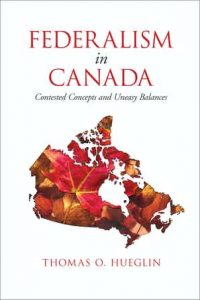If aliens invaded, a prime minister’s first duty would be to get premiers on the phone. Airspace is clearly federalized under the Aeronautics Act. But what if invaders land on islands and travel by ferry to terrorize the populace? If it’s a British Columbia ferry, that is provincial jurisdiction. Newfoundland and Labrador ferry, federal.
The space enemy may use laser beams to make trees explode or boil mountain lakes. That is clearly provincial jurisdiction. But let one errant death ray touch a single rivet on a railway trestle and you are dealing with the Government of Canada, my friend.
This is “the incredible fragmentation we have in this country among federal, provincial and municipal governments,” as Senator Howard Wetston (Ont.), a former federal judge, once put it. Wetston was referring to regulation of light bulbs.
Federalism In Canada puts all the pieces together, but with a striking difference. Scholar Thomas Hueglin is not from here. Hueglin is German-born. With a completely open mind, he did what every political scientist should do: jump in the car.
“One could not understand Canada nor its bewildering literature on federalism without having seen it, the vast spaces separating one region from the other,” writes Hueglin. “In southern Germany, where I grew up, one could drive to five countries within a few hours. Just to get out of Ontario took almost exponentially more time. With distance came diversity.”
“In Winnipeg I saw the railyards connecting the two halves of the country,” recalls Hueglin; “In Calgary I was shown the new PetroCan building as a sinister symbol of Trudeau’s centralist machinations.” This was 1983.
Hueglin discovered the traveler’s secret hidden from Ottawa, “a remote lumber town.” Nobody who drives from Winnipeg to Vancouver is struck by the all-seeing presence of the federal government. Hueglin spent a week reading the Saskatoon Star-Phoenix and found a single reference to Ottawa. “The physical distance between Ottawa and Saskatoon is nearly 3,000 kilometres and neither city is anywhere near the edge of the country,” he writes.
Federalism In Canada is fresh and matter of fact, a constitutional travelogue. The genius of Canada is the pride and purpose of the provinces, so different one from the other. Scholars for years have argued whether this was a happy accident or a reflection of the genius of Fathers of Confederation. Professor Hueglin falls into the “happy accident” camp, but 154 years of success speaks for itself.
“Confederation not so much constituted a universal agreement on first principles as it was a working compromise allowing for different interpretations for each of the participants,” writes Hueglin. The contrasts between participants are striking.
“I crossed from Saskatchewan into Alberta, two provinces a world of political culture apart yet indistinguishable from one dusty Prairie town to the next,” writes Hueglin. The same could be said of Nova Scotia and Prince Edward Island, Yukon and the Northwest Territories.
Our country is “an agreement cobbled together,” writes Hueglin. “Remarkable,” he concludes. “All through its history there have been and still are deep disagreements about the meaning of federalism,” and for all that here we are in Year 155.
By Holly Doan
Federalism in Canada: Contested Concepts and Uneasy Balances, by Thomas O. Hueglin; University of Toronto Press; 384 pages; ISBN 9781-4426-36453; $54.95





